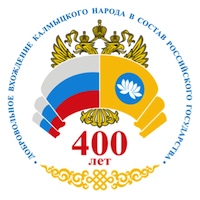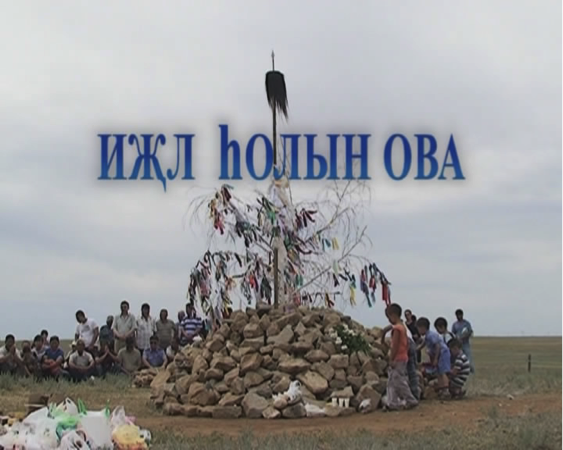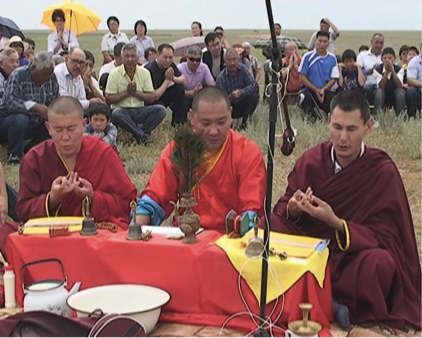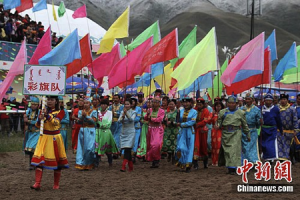DJB
Reposted from the China Heritage Quarterly.
The last decade has seen a lot of new anniversaries cropping up in Central Asia. Newly independent republics such as Uzbekistan and Kazakhstan have swapped old Soviet holidays for new, nationally specific events, often dedicated to demonstrating the antiquity of the nations concerned. In 2007 Samarkand celebrated its 2750th birthday, and in 2009 Tashkent turned 2200. This year, along with the centennial of the Mongolian declaration of independence, Mongolians will mark the 2220th anniversary of the founding of the Xiongnu 匈奴 empire.
These celebrations are often combined with national day events, and they clearly play a role in justifying the presence of these countries as sovereign states. It is worth noting, though, that commemorations of such historical landmarks are equally prominent in places that are still tied to bigger political units, in this case as part of Russia or China. In Russia, it is precisely the lack of sovereignty of the remaining non-Russian peoples that is deemed worthy of celebration. Such events first appeared on the scene as part of post-war Soviet patriotism, and are now promoted by Vladimir Putin and his “United Russia” Party. They are generally referred to as the anniversary of the “voluntary annexation” (добровольное вхождение) of people X into Russia.
In 2007, for example, the Bashkirs celebrated 450 years as part of Russia. In July this year, Buryatia marked 350 years since the coming of the Cossacks.
This is not all that surprising. Much of the rehabilitation of Tsarist colonial expansion was already carried out in the Soviet period, where a consensus was built around the “progressive nature” of the Russian presence on its periphery. Monuments to such “voluntary annexations” were not unknown: one was put up in Turkmenistan in 1981, only to be quietly removed under perestroika.
The Kalmyk Mongols are a particularly interesting case. The partition of the steppe between the Russian and Qing empires left the western Mongols (to which they belong) a divided community. In the seventeenth century some migrated to the shores of the Caspian, the rest remaining in Jungharia to face the Qing invasion in the 1750s. In 2009 the 400-year anniversary of the Kalmyks’ incorporation into the Russian Empire was celebrated in Elista, the capital of the Republic of Kalmykia.
Despite the distance between Xinjiang and the Volga, there continued to be significant movement back and forth between the two communities during the Qing, culminating in the famous migration of the Torghud, one section of the Russian Kalmyk population, back to Xinjiang in the 1770s. Many thousands perished on the way, and the decision to leave Russia has gone down in Kalmyk history as a national tragedy.
To mark the passing of 240 years since this ill-fated migration to Jungharia, a cultural society in Kalmykia erected a shrine (oboo) this past May, and held prayers there for the dead.
The director of this society explained the significance of 1771 in stark terms:
The tragedy of 1771 consists not only in the significant loss of population to our ethnic group (etnos). We lost our own state. To this day our people have been unable to make up the human, spiritual, and cultural losses that they sustained in that disastrous year. (LINK)
In China, on the other hand, the return of the Kalmyks to China is a happy occasion, one that must be celebrated. And this October it was, with naadam festivities held in the Mongolian autonomous prefecture of Bayingol (巴音郭楞蒙古自治州), home to the biggest group of Torghud in Xinjiang.
Making a political football out of the Xinjiang Mongols is nothing new. The Qianlong Emperor reveled in the return of the Torghud as the crowning glory of his reign. What better proof could there be of the attraction exerted by his universal majesty than to induce this long-lost tribe of Mongols to make the arduous journey across the steppe and submit? Steles were inscribed, a new temple was erected at Chengde, and Torghud nobles were invited on imperial hunts to ritually cement their loyalty.
Such self-congratulatory preening has since been updated to meet the political needs of the PRC, in which the Torghud migration demonstrates not the glory of the Qing, but the love of China’s ethnic groups for each other and for the motherland. Xinjiang scholar Ma Dazheng took advantage of the occasion to give his interpretation of the Torghud migration. According to Ma, by the time of their exodus to the Volga (i.e. by the seventeenth century), the Kalmyks were already intimately linked to the culture and people of the central plains of China, and had become one of the constituent members of China’s multi-ethnic nation. Hence the migration back was motivated by patriotism towards China.
Even if we allow for the conflation here of the Qing dynasty with China, this is far fetched. A much more convincing account of the migration is given by C. D. Barkman:
It is quite clear that the Torghuts had not intended to surrender to the Chinese, but had hoped to lead an independent existence in Dzungaria. Only after much hesitation did they accept this pis-aller which was forced upon them by the circumstances. The terrible blows they had received at the hands of the Kazaks and Buruts…and the long trek through Central Asia had left them utterly exhausted and without the strength to force their way into Sinkiang and to ignore Chinese power in that region.
But my interest here is not in the rights and wrongs of Kalmyk history. Instead it is to ask, what is the relationship between the historical debate and the appearance of these anniversaries now? One can see how in Russia’s case the 400th year since the Kalmyks’ submission might be worth calling attention to, but 240 years seems a strange length of time to mark. Why not wait until 250 years? Did the decision to observe the anniversary in Kalmykia influence the way it was celebrated in Xinjiang? We can imagine how pictures of Kalmyks in Russia mourning the fate of those who set out for China were greeted in Ürümchi and Beijing. After all, if Ma Dazheng is correct that in the 1600s the Kalmyks were already a member of the happy family of ethnicities that is China, then the only tragedy here is that these Kalmyks chose to leave and become subjects of the Tsar.
One cannot help but sense a certain urgency here to reinforce established narratives, and the reemergence of a public debate that has long been confined to scholarly circles. Apart from jostling between Russia and China, an obvious reason for this is the growing opportunity for communication between Kalmyks and Xinjiang Torghud, brought about by the cautious and selective opening-up of both countries. Such contacts may prompt a fresh look at assumptions that each side have made about the other in the course of many years of estrangement.
In October a delegation of Kalmyk citizens travelled to Xinjiang to take part in the Torghud naadam festivities, and the impressions they returned with were printed in an article in Izvestiia Kalmykii on September 10. One member of the party describes the cognitive dissonance he felt at witnessing the celebration of an event he always thought of as a black day in his nation’s history:
We are accustomed to thinking of this event as a great tragedy, but among the Xinjiang Kalmyks [it is thought of] as a joy. Thus they celebrated the date just as extravagantly as the 400-year anniversary of the incorporation of the Kalmyks into Russia was celebrated two years ago.
A theme that runs through Kalmyk discussion of the Xinjiang Mongols is that they preserve a culture and nomadic way of life that reflects an earlier, more pristine stage in the development of the Kalmyk nation. Once these features might have been dismissed as evidence of backwardness, and confirmation of the Soviet Kalmyks’ cultural progress. Now, though, such markers of national identity are highly prized. The visitors from Kalmykia describe their pleasure at spending a night in a yurt (for the first time?), and wax romantic at the untouched landscape:
An impressive scene opened up before us: the green valley, a river flowing with clear water, the tents of the nomads… All this strongly called to my mind the description of the land of Bumba in the Jangar epic.
Such sentiments are not exclusive to the Kalmyks. The feeling of both cultural superiority and cultural loss vis-à-vis communities in China can be witnessed among Uyghurs and Kazakhs living in the former Soviet Union. As China develops, more such divided groups will reconnect and renegotiate their relationship to each other. Delegations of Hui Muslims from Gansu and Ningxia, for example, have visited Dungan communities in Kirghizstan in recent years. No doubt similar exchanges are taking place along the rest of China’s borders. What will the long term trend be here? How will perceptions of ethnic brethren in China change as perceptions of China change? Will history facilitate or hinder these new ties? Or will these new ties change the way history is written?
References
C. D. Barkman, “The Return of the Torghuts from Russia to China,” Journal of Oriental Studies 2 (1955): 89-115.
Tat’iana Il’ina, “Kalmytskii iazyk v Kitae,” Izvestiia Kalmykii, September 10, 2011.




